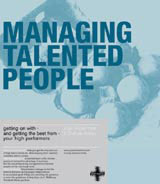Managing the talent pool and keeping dry
Fortunately for designers, talent is often equated with creativity. But do we know how best to manage it? Simon John thinks getting it right is central to success

‘This person is a talented individual and deserves public recognition and praise for their great work.’ How often have you said these words or something similar? We tend to rely on organisations like British Design & Art Direction to recognise and praise great work and talent. But when it comes to a company recognising its own the issue becomes complicated.
How do we judge who is, and by default who is not, talented? Is this assessment based on the potential of the individual, or is it down to the person who makes the judgement? And with judgement comes a certain responsibility – do we always live up to that?
What about the pressure to perform once you are labelled as talented? Your position within a company becomes elevated, relationships with peers can be affected, and the pressure to perform can obstruct the very talent itself.
With most successful creative companies, the recognition and management of talent are central to their success.
This subject is explored by a new book, Managing Talented People, by Alan Robertson and Graham Abbey, a management consultant and Easyjet’s head of HR respectively.
Picking it up, my immediate response conjured an image of talented people being fettered by the structure of an organisation similar to the office in Terry Gilliam’s film Brazil.
Cold sweat over, I found the book deals with a lot of the issues we face as managers of creative people, for example: ‘Why are the most talented often the most rewarding people to have in your team and yet, at the same time, the most challenging to manage?’
What do we mean by talent though? The dictionary defines it as ‘1. a special aptitude or faculty. 2. high mental ability’. But surely talent goes beyond mere skill or intelligence?
In my experience, talent is about being exceptional. Talented people are unconventional and unique; they have a distinctive style, they think laterally and are innovative – they thrive on ideas and they like to put ideas into action.
Three particular characteristics distinguish extraordinary individuals. They are good thinkers, possess strong self-awareness, and are assiduous learners. Robertson and Abbey distil this down to one simple assertion, that talent is mainly about creativity. ‘Labelling someone “talented” revolves around an expectation of creativity,’ they write.
According to the authors, those most likely to be labelled as talented are artists, actors and musicians. The jobs least likely to fit the bill include accountants, bankers and, wait for it, managers. In other words, creativity is central to perceptions of talent. And here, if their assessment is correct, lies the challenge.
While management tends to be a largely rational discipline, talent on the other hand leans more towards the emotional. And when things start getting emotional, management becomes difficult.
One question the book raised for me was the difference between managing talented people, and just managing people. Is there really such a big difference?
I think that there is, if only because ‘normal’ people generally like to follow direction, whereas talented people are almost always strongly independent – they like to go their own way. So managing talented people is less about direction and more about inspiration and facilitation.
In fact, Robertson and Abbey claim, ‘talented people are essentially uncontrollable’. My experience is mixed on this one and yet, the authors contend, ‘talented people are those expected by their managers to produce superior performance both now and in the future… They achieve this through urgent application of their creativity while demanding growth with or without the support of the broader organisation’.
Another theme centres around the political nature of talent. Are the expectations of the talented and management expectations pulling in opposite directions?
‘The talent question is political,’ Robertson and Abbey write. ‘It involves people’s interests. The personal stakes are high. And organisations, gatherings of people, places where interests inevitably compete are therefore places where it is not easy to speak openly about talent.’
Managers recognise it is a prized resource, but ‘hedge bets’ on the precise nature of talent, due in part to a lack of understanding of its dimensions. It gets to the point when we are able to say ‘let’s leave the talent (read creative) alone to solve this one’ without in many cases asking how.
The mystery or ‘fuzziness’ described in the book only adds to the perceived or real value of talent – indeed, the fuzziness creates the fizz that is so valuable.
Managing Talented People is worth a read, as it explores important issues directly affecting the creative industry. Its structure is very easy to dip into – with clear headings, bullet points and quotations – and it has an easygoing style, even if the tone is at times rather irritating.
Such accessibility also leaves it light on sources to reinforce arguments though – which can weaken some of the thinking.
Three steps to managing talent
1 Alert the talented, and others, to their talent
2 Enable the individual to perform and develop
3 Inspire and stimulate talent
Simon John is a partner of independent brand consultancy Ergo.
Managing Talented People is published by Pearson Education. See www.yourmomentum.com for details
-
Post a comment




